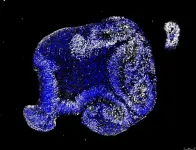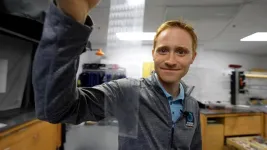(Press-News.org) June 22, 2023, NEW YORK – Researchers at the Ludwig Center at Harvard have developed a platform technology for imaging that enables integration of the methods of microscopic analysis long employed in pathology laboratories with the visualization of multiple molecular markers in individual cells that is now rapidly advancing in research labs. The latter capability, known as “multiplex” imaging, promises to revolutionize cancer diagnostics by exposing molecular traits associated with such things as a cancer’s aggressiveness or its potential vulnerability to therapy. It has, however, remained largely confined to academic labs because its methods tend to be incompatible with the standardized processes of tissue processing and staining employed for diagnosis in clinical pathology.
In the current issue of Nature Cancer, researchers led by Ludwig Harvard’s Sandro Santagata, Peter Sorger, Jia-Ren Lin and Yu-An Chen report the development of a platform, named Orion, that bridges these parallel worlds of microscopic analysis. They also validate the platform, demonstrating its use by both human experts and artificial intelligence algorithms in identifying cellular and molecular features in tumors that predict the progression-free survival of colon cancer patients.
“What this all boils down to is that Orion is a tool designed for practical use in real-life clinical settings,” said Santagata. “While the platform can certainly benefit basic cancer research, its primary focus is to enhance the diagnosis of human diseases. That has been our goal since the beginning.”
Clinical pathology relies on the microscopic analysis of tissues embedded in wax, sliced into strips about a fifteenth the width of a human hair and stained with hematoxylin and eosin (H&E) to expose the fine morphology of cells. Today, researchers are increasingly applying machine learning and artificial intelligence algorithms to the pink-and-purple images of H&E-stained tissues. Such work—which is further enriched by the ability to draw from millions of archived H&E images and samples—identifies patterns not readily apparent to the human eye, revealing information that can help improve the diagnosis and management of cancer therapy.
Meanwhile, the use of antibodies to capture molecular characteristics of tumors has evolved rapidly over the past four decades and is now indispensable to cancer diagnostics. More recently, researchers have begun simultaneously applying scores of antibodies to tissues, linking “immunofluorescence” images generated this way to gene expression in cells to generate richly textured portraits of tumors.
“With the molecular information we gather, we can identify distinct cell types, determine their current state, understand their neighboring cells and assess how they may be interacting to promote tumor growth,” Santagata explained.
A couple of issues have, however, limited the application of multiplex imaging in the clinic. First, its methods do not generally permit the evaluation of whole slides—a requirement of clinical diagnostics. Nor are they compatible with those of H&E microscopy, the workhorse of clinical pathology.
“Our platform paves the way for bridging the domains of H&E diagnostics and multiplexed tissue imaging,” said Santagata. “We have developed techniques to combine multiple antibody images with H&E staining of the same tissue section, enabling the integration of information from each source into a comprehensive view across the entire slide.”
The Ludwig Harvard team partnered with a Seattle, WA, startup named RareCyte and drew additionally on support from the Ludwig Tumor Atlas project and a Small Business Innovation Research grant from the National Cancer Institute to develop a new microscope and processes at the heart of the Orion platform.
To test the platform, the researchers analyzed colorectal cancer specimens from 40 patients to find molecular features most closely associated with bad outcomes. Sifting through some 15,000 combinations of biomarkers, they identified those most tightly linked to patient prognosis and applied them to samples from 34 other colorectal cancer patients whose outcomes were known. The researchers show that their biomarkers predicted with high accuracy—just a 1 in 20 chance of being wrong—the likelihood of poor prognosis.
Notably, combining multiplex and H&E imaging revealed relationships between the molecular markers, cell morphology and tumor topography that were illuminating. One such finding indicated that inflammation—or immune activity—at the rim of the tumor is of pathological significance. Another revealed the molecular basis of a tissue morphology associated with propensity for metastasis.
“Cancer cells typically grow together in sheets, but sometimes they lose their ability to stick together, resulting in the release of fragmented clusters. Malfunctions in the machinery of cellular adhesion can make cancer cells more invasive,” explained Santagata. “During our analysis, we saw that a critical marker of cell adhesion was decreased in tumors displaying invasive characteristics, and this reduction was associated with unfavorable outcomes.”
The researchers now plan to continue establishing proof of concept for their platform, exploring markers of such things as treatment response and resistance. Ultimately, the discoveries made using Orion will have to be validated in large clinical trials.
“The prospect of incorporating high-powered advanced imaging tools to analyze routine clinical samples is very exciting,” said Santagata. “It promises to unlock a wealth of knowledge about cancer tissues.”
Sandro Santagata is an associate professor in the Department of Pathology at Brigham and Women’s Hospital and an associate professor of systems biology at Harvard Medical School.
Peter Sorger is Otto Krayer Professor of Systems Pharmacology at Harvard Medical School.
This study was supported by Ludwig Cancer Research, the National Cancer Institute, Bill and Melinda Gates Foundation, the Gray Foundation, the David Liposarcoma Research Initiative, the Emerson Collective and the Brigham and Women’s Hospital.
# # #
About Ludwig Cancer Research
Ludwig Cancer Research is an international collaborative network of acclaimed scientists that has pioneered cancer research and landmark discovery for more than 50 years. Ludwig combines basic science with the ability to translate its discoveries and conduct clinical trials to accelerate the development of new cancer diagnostics and therapies. Since 1971, Ludwig has invested nearly $3 billion in life-changing science through the not-for-profit Ludwig Institute for Cancer Research and the six U.S.-based Ludwig Centers. To learn more, visit www.ludwigcancerresearch.org.
For further information please contact communications@ludwigcancerresearch.org
END
From June 21 through June 27, the largest gathering of NF researchers, clinicians, and patients in the world will take place at the Fairmont Scottsdale Princess in Scottsdale, Arizona. NF is a group of genetic disorders that causes tumors to grow on nerves throughout the body, and affects 1 in 2,000 births of all populations equally. As such, NF affects millions worldwide, but is underrecognized. While there is one approved treatment for a small subgroup of NF patients with plexiform neurofibromas, there is no cure yet, and the vast majority of NF patients face serious health issues because of the condition. ...
The installation of Aurora’s 10,624th and final “blade” marked a major milestone for the highly anticipated exascale supercomputer at the U.S. Department of Energy’s (DOE) Argonne National Laboratory.
After years of diligent work and planning, the system now contains all the hardware that will make it one of the most powerful supercomputers in the world when it is opened up for scientific research. Built by Intel and Hewlett Packard Enterprise (HPE), Aurora will be theoretically capable ...
Black sexual minority men (BSMM) and transgender women (BTW) face racial and sexuality-based discrimination, and disproportionately high depression compared to Black heterosexual men and Black cisgender women, respectively. Though previous studies have demonstrated the relationship between discrimination and depression among racial and sexual minorities, few studies explore the extent to which openness with parents impacts this relationship.
A new study by College of Public Health Assistant Professor Rodman Turpin found that sexual identity ...
We are honored to announce that Transforming Anthropology will join the University of Chicago Press journals program beginning in 2024 (vol. 32, no. 1). Transforming Anthropology is the flagship journal of the Association of Black Anthropologists (ABA), which is a section of the American Anthropological Association (AAA). All 8,000+ members of the AAA receive online access to Transforming Anthropology through their membership, and that benefit will continue in this new partnership.
“Thanks to the vision and dedication of our editor, Aisha Beliso-De Jesús, the journal will maintain its tradition of supporting and nurturing ...
The Lehigh University Industrial Assessment Center (IAC) will expand into the Mid-Atlantic Regional IAC Center of Excellence (MARICE) with newly awarded funding from the U.S. Department of Energy (DOE).
Lehigh’s IAC was established in 2001 as part of the DOE’s nationwide Industrial Assessment Center Program to reduce energy and waste and enhance productivity for manufacturing plants in Pennsylvania, New Jersey, and New York. The center, which was most recently renewed in 2021, is led by mechanical engineering and mechanics (MEM) faculty Professor Alparslan ...
Alzheimer's disease (AD) mainly affects the older population. Recent research found early disease signs in cell culture models of early human brain development, raising the possibility that the disease has its origins much earlier in life, possibly during embryogenesis – the formation and development of an embryo.
Alzheimer’s disease is a highly prevalent, debilitating, and potentially fatal neurodegenerative disease with limited treatment options. Patients are typically diagnosed at an advanced disease stage, limiting the possibilities for early therapeutic intervention. Although for most patients ...
Researchers at Karolinska Institutet in Sweden have identified a group of nerve cells in the mouse brain that are involved in creating negative emotional states and chronic stress. The neurons, which have been mapped with a combination of advanced techniques, also have receptors for oestrogen, which could explain why women as a group are more sensitive to stress than men. The study is published in Nature Neuroscience.
Just which networks in the brain give rise to negative emotions (aversion) and chronic stress have long been unknown to science.
By using ...
Ian Dalziel of The University of Texas at Austin has been honored with the Polar Medal — the United Kingdom’s top award for polar exploration. The medal recognizes Dalziel’s contributions to Antarctic geology, including discoveries about the icy continent’s ancient past and the fragility of its ice sheet today. The award will be presented by King Charles III at Buckingham Palace later this year.
Early recipients of the medal, which has existed for more than 150 years, include pioneers of polar exploration Capt. R.F. Scott and Sir Ernest Shackleton, who made the first attempt to reach the South Pole in 1902. Dalziel’s ...
Adhesive tape fulfills many purposes, from quickly fixing household appliances to ensuring a reliable seal on a mailed package. When using tape with a strong bond, removing it may only be possible by scraping and prying at the tape's corners, hoping desperately that surface pieces don’t tear away with the tape.
But what if you could make adhesives both strong and easily removable? This seemingly paradoxical combination of properties could dramatically change applications in robotic grasping, wearables ...
A new study led by researchers from the Mass General Brigham healthcare system suggests that taking a “food is medicine” approach could increase nutrition security for families and lead to reductions in body mass index (BMI) in children. Working together with the MGH Food Pantry, researchers from the Massachusetts General for Children and Boston Children’s Hospital examined whether providing weekly plant-based foods to families seeking food assistance during the pandemic led to weight changes among children.
The team found an association between increasing receipt of food packages and decreased BMI. The findings, published ...






